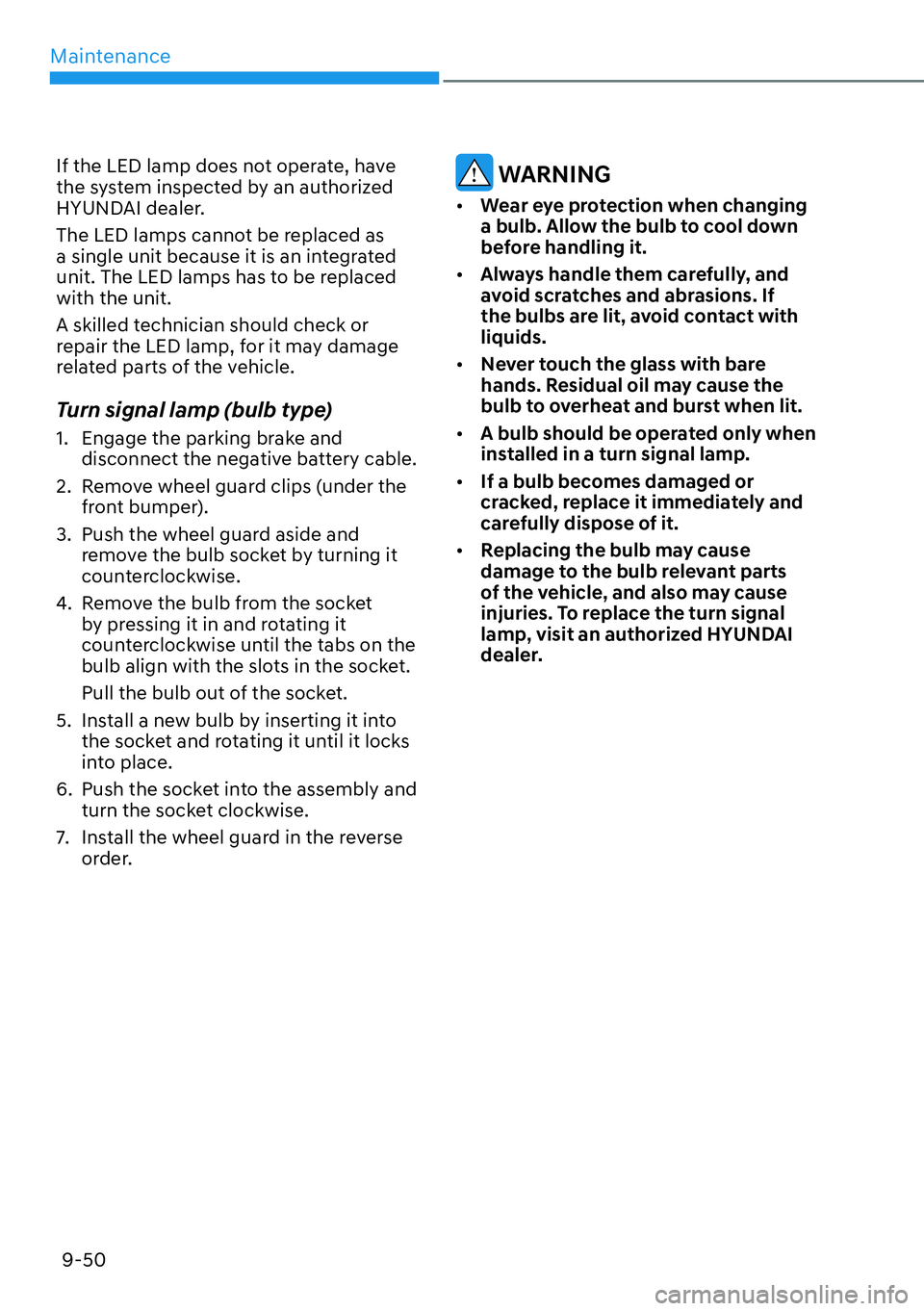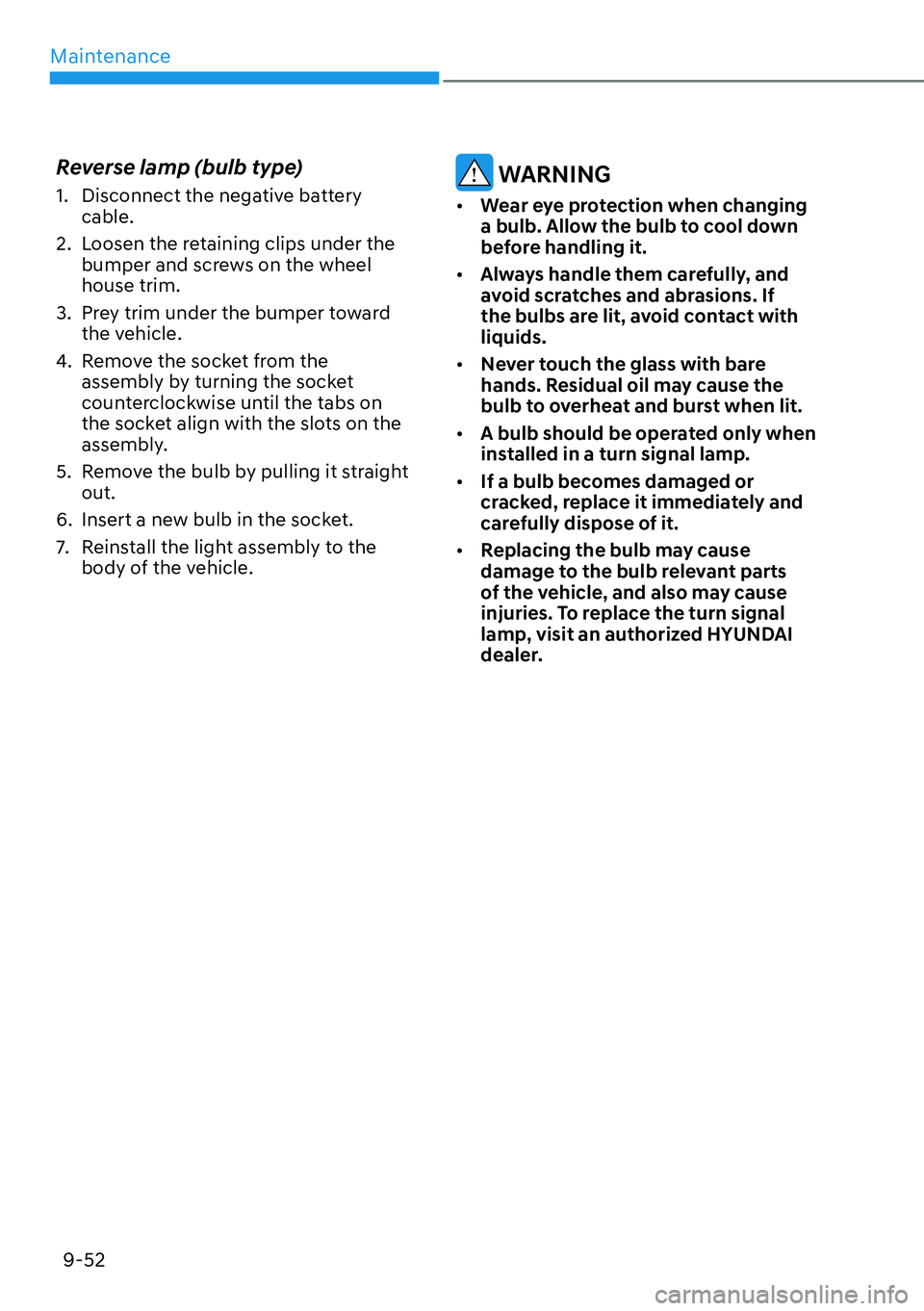Page 646 of 663
09
9-47
Fuse NameFuse Rating Circuit Protected
WIPER125A PCB Block (Wiper Main Relay)
EPCU115A Front Inverter (AWD)
HORN15APCB Block (Horn Relay), PCB Block (Burglar Alarm
Horn Relay)
WIPER27.5A IBU
VCU215A VCU
IG3 120A ICU Junction Block (Fuse : F14, F16, F24)
IG3 315A Electronic Water Pump
IG3 510A BMS Coolant 3Way Valve
VCU310A VCU
IG3 410AA/C Coolant Valve, Electronic Water Pump #1, #2,
Electronic A/C Compressor
IEB310A Multipurpose Check Connector, IEB Unit
IG3 610A Cooling Fan Motor, Front Electronic Oil Pump (AWD)
MDPS2 *
110A MDPS Unit
IG3 215A Front Inverter (AWD), VCU
*1 : MDPS (Motor Driven Power Steering) is the same as EPS (Electric Power Steering)
Page 649 of 663

Maintenance
9-50
If the LED lamp does not operate, have
the system inspected by an authorized
HYUNDAI dealer.
The LED lamps cannot be replaced as
a single unit because it is an integrated
unit. The LED lamps has to be replaced
with the unit.
A skilled technician should check or
repair the LED lamp, for it may damage
related parts of the vehicle.
Turn signal lamp (bulb type)
1. Engage the parking brake and
disconnect the negative battery cable.
2. Remove wheel guard clips (under the
front bumper).
3. Push the wheel guard aside and
remove the bulb socket by turning it
counterclockwise.
4. Remove the bulb from the socket
by pressing it in and rotating it
counterclockwise until the tabs on the
bulb align with the slots in the socket.
Pull the bulb out of the socket.
5. Install a new bulb by inserting it into
the socket and rotating it until it locks
into place.
6. Push the socket into the assembly and
turn the socket clockwise.
7. Install the wheel guard in the reverse
order.
WARNING
�[��Wear eye protection when changing
a bulb. Allow the bulb to cool down
before handling it.
�[��Always handle them carefully, and
avoid scratches and abrasions. If
the bulbs are lit, avoid contact with
liquids.
�[��Never touch the glass with bare
hands. Residual oil may cause the
bulb to overheat and burst when lit.
�[��A bulb should be operated only when
installed in a turn signal lamp.
�[��If a bulb becomes damaged or
cracked, replace it immediately and
carefully dispose of it.
�[��Replacing the bulb may cause
damage to the bulb relevant parts
of the vehicle, and also may cause
injuries. To replace the turn signal
lamp, visit an authorized HYUNDAI
dealer.
Page 651 of 663

Maintenance
9-52
Reverse lamp (bulb type)
1. Disconnect the negative battery
cable.
2. Loosen the retaining clips under the
bumper and screws on the wheel
house trim.
3. Prey trim under the bumper toward
the vehicle.
4. Remove the socket from the
assembly by turning the socket
counterclockwise until the tabs on
the socket align with the slots on the
assembly.
5. Remove the bulb by pulling it straight
out.
6. Insert a new bulb in the socket.
7. Reinstall the light assembly to the
body of the vehicle. WARNING
�[��Wear eye protection when changing
a bulb. Allow the bulb to cool down
before handling it.
�[��Always handle them carefully, and
avoid scratches and abrasions. If
the bulbs are lit, avoid contact with
liquids.
�[��Never touch the glass with bare
hands. Residual oil may cause the
bulb to overheat and burst when lit.
�[��A bulb should be operated only when
installed in a turn signal lamp.
�[��If a bulb becomes damaged or
cracked, replace it immediately and
carefully dispose of it.
�[��Replacing the bulb may cause
damage to the bulb relevant parts
of the vehicle, and also may cause
injuries. To replace the turn signal
lamp, visit an authorized HYUNDAI
dealer.
Page 658 of 663

09
9-59
Underbody maintenance
Corrosive materials used for ice and
snow removal and dust control may
collect on the underbody. If these
materials are not removed, accelerated
rusting can occur on underbody parts
such as the frame and floor pan, even
though they have been treated with rust
protection.
Thoroughly flush the vehicle underbody
and wheel openings with lukewarm or
cold water once a month, after off-road
driving and at the end of each winter. Pay
special attention to these areas because
it is difficult to see all the mud and dirt.
It will do more harm than good to wet
down the road grime without removing
it. The lower edges of doors, rocker
panels, and frame members have drain
holes that should not be allowed to clog
with dirt; trapped water in these areas
can cause rusting.
WARNING
After washing the vehicle, test the
brakes while driving slowly to see if
they have been affected by water. If
braking performance is impaired, dry
the brakes by applying them lightly
while maintaining a slow forward
speed.
Aluminum wheel maintenance
The aluminum wheels are coated with a
clear protective finish.
�[��Do not use abrasive cleaner, polishing
compound, solvent, or wire brushes
on aluminum wheels.
�[��Clean the wheel when it has cooled.
�[��Use only a mild soap or neutral
detergent, and rinse thoroughly with
water. Also, clean the wheels after
driving on salted roads.
�[��Do not wash the wheels with high-
speed car wash brushes.
�[��Do not use any cleaners containing
acid or alkaline detergents.
Corrosion protection
Protecting your vehicle from corrosion
By using the most advanced design
and construction practices to combat
corrosion, HYUNDAI produces vehicles
of the highest quality. However, this is
only part of the job. To achieve the long-
term corrosion resistance your vehicle
can deliver, the owner’s cooperation and
assistance is also required.
Common causes of corrosion
The most common causes of corrosion
on your vehicle are:
�[��Road salt, dirt and moisture that is
allowed to accumulate underneath
the vehicle.
�[��Removal of paint or protective
coatings by stones, gravel, abrasion
or minor scrapes and dents which
leave unprotected metal exposed to
corrosion.